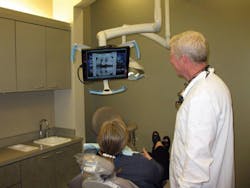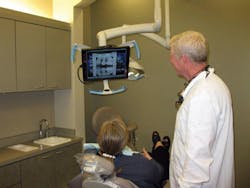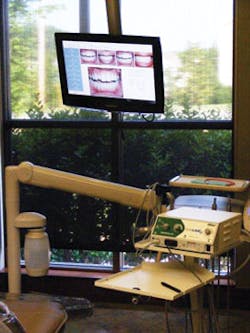How and when to integrate technology
by Jeff Carter, DDS, and Pat Carter, IIDA
In 1998, we took part in an expert roundtable discussion on whether computers were appropriate in the operatory. The group was skeptical about how useful this clunky box with a noisy fan, bulky 13" tube monitor, and cabled inputting devices would be in delivering dental treatment. We were correct in our assessment that technology was the future of dentistry, and computers in the operatory were just the beginning. I (Jeff) may have been convinced of this "appropriateness" by watching too many Star Trek episodes, but the call was still the right one.
Fourteen years ago there was skepticism regarding the value of technology in dentistry, or at least in the operatories. Today we may have transitioned to the other extreme, where we assume technology will solve any trouble we may have in the dental office. In our opinion, designing a facility for either end of the technology extreme is not advised. The goal of this article is to assist you in finding the proper balance in purchasing and integrating the latest technology for your facility. Balance is essential, whether you're trying to figure out how to take intraoral radiographs in all three of your existing operatories, or you're envisioning a new ground-up 13,000-square-foot building with multispecialty capability.
Fortunately, successful dental manufacturers attempt to minimize the facility impact of integrating any new or improved device, piece of equipment, or component. More potential sales exist for plug-and-play products that build upon existing technology infrastructure.
Consider the following products for your practice based on the benefits and cost implications.
Nomad handheld X-ray units are rapidly gaining regulatory acceptance and market share. We have not designed infrastructure for a traditional wall-mounted periapical X-ray unit in the operatories in the last three years due to our design clients switching to handheld units.
Usage benefits
• Take intraoral radiographs from almost any conceivable angle and dental chair position
• Improve operatory esthetics by eliminating bulky wall-mount units
• Free up precious space in operatory for additional useful equipment and cabinetry
Potential cost savings
• Eliminates requirement for "in-wall" plywood blocking attached to framing members
• Eliminates dedicated electrical outlet
• Reduces circuit breaker count in electrical panel(s)
• Reduces equipment costs - one shared handheld X-ray unit can accommodate three operatories vs. purchasing fixed and wall-mounted periapical units in each operatory
Cone beam units (computed tomography) are probably a close second to the handheld X-ray units in market share gains vs. traditional panoramic or panoramic-cephalometric X-ray units. Initially, the first generation i-CAT and other early CT unit models had a larger footprint than the typical digital panoramic unit, which challenged many to retrofit the CT unit into their existing facility without moving walls and compromising existing space. More recently, the CT units are comparable in size to many standard digital panoramic units, greatly simplifying retrofit opportunities.
Usage benefits
• Tremendous diagnostic information
• A terrific addition to group practices with multispecialty focus and team approaches to complex cases
Potential cost savings
• The CT units are priced significantly higher than digital panoramic units, but the market is competitive and CT unit pricing has dropped recently. Unlike handheld units, there is no comparable initial cost savings purchasing CT vs. traditional panoramic units. You can make the case that the CT unit diagnostic value greatly reduces potential liability from misdiagnosis and increases diagnostic opportunities, leading to more production per case and a significant cost savings.
CAD/CAM units, such as the multiple generations of CEREC by Sirona, or E4D by D4D Technologies, a more recent entry to the market, can be very significant and productive additions to your practice. Approximately 50% of our recent general practice design clients have chosen to integrate CAD/CAM into their facilities.
Usage benefits
• One-visit crowns and partial coverage restorations typically associated with multiple visits and outside lab work
• Elimination of temporaries
• Elimination of impressions
Potential cost savings
• CAD/CAM units are a significant investment for any practice. Many CE courses are available to justify purchasing this technology - justifications that factor in reduced lab bills, higher case acceptance, and overall reduced chairtime per procedure.
LED patient lights, in our opinion, are sophisticated technology products and very much worth your consideration. A-dec, Midmark, and Pelton & Crane are examples of quality manufacturers that offer LED dental patient lights.
Usage benefits
• Superior light source for shade matching and identifying tissue pathology
• Built-in filters allowing alternative settings that remove the light-curing spectrum, a problem in previous generations of dental patient lights
• Less heat output - always a good thing in operatories
Potential cost savings
• Reduced energy consumption
• Time savings in infection control process due to more compact and seamless design
• Less waste of composite materials due to better control of curing process
"Dry" vacuum pumps have recently become the industry standard for dental vacuum systems and have supplanted the wet vacuum systems of the past. Midmark and other manufacturers produce quality "dry" vacuum units with multiple sizing options.
Usage benefits
• Superior suction strength over traditional wet vacuum pumps up to 18 mm/HG
• Much quieter motors
• On-demand performance characteristics decrease overall heat output
Potential cost savings
• Reduced energy consumption and electrical bills from on-demand performance
• Tremendously reduced water consumption and water bills over wet vacuum pump systems
• Units are typically "oil-less" and no maintenance is required, which reduces service-related billings
• Reduced installation costs due to simplified plumbing and sound-insulation requirements
Delivery systems have been totally redesigned in recent years due in part to merging core dental function with information technology advancements. The control head (housing for hand-pieces, suction, and air/water syringe, etc.) of most major manufacturers has been upgraded to integrate smaller equipment items such as electric handpieces, intraoral cameras, ultrasonic or piezoelectric scalers, air abrasion, curing lights, and endodontic motors.
Usage benefits
• Vastly improved ergonomics due to centralizing additional functions within operator reach
• Improved positioning allows flexibility in mounting solutions
• Fully ambidextrous options for dual-function rear delivery and chair-mount split delivery
• Built-in flushing systems for proper maintenance of dental unit waterlines
Potential cost savings
• Increased production capability from ergonomic efficiencies
• Use of bottled water to delivery unit decreases overall facility water consumption
• Multifunction units can be serviced by one technician vs. multiple separate units purchased through different manufacturers
Dental furniture cabinetry systems for operatories and sterilization areas have also advanced significantly in recent years. Many manufacturers combine assistant modules or dual-function rear delivery unit modules with a 12 o'clock cabinet in the operatories. This cabinet is a unique blend of cabinetry modules, utility outlets, mounting brackets for monitors, delivery units, and even technology access receptacles, such as USB connection faceplates for connection to digital X-ray sensors.
Kick plates connected to compressed air hydraulics is an interesting hands-free option to open and close upper cabinet doors on 12 o'clock operatory cabinets and/or sterilization upper storage cabinets. It is not feasible to duplicate this unique option in custom cabinet alternatives.
Usage benefits
• Improves ergonomics by centralizing additional components within operator and assistant reach, including CPU, monitor, inputting devices, N2O2 connections, flowmeters and rubber goods, clean tray storage, and timers
• Increased durability for manufactured cabinets
• Computerized tracking by manufacturers provides for factory replacement of worn or damaged cabinet components for many years
Potential cost savings
• Increased production capability from ergonomic efficiencies
• Increased durability and greater lifespan of manufactured units. For example, Midmark offers clinical cabinetry with a steel substructure built to withstand the most rigorous dental environments.
Dental patient chair advancements are significant investments for dental manufacturers to undertake, and the release of a new chair by a major manufacturer deserves your acknowledgement and consideration if you're in the market for a new chair. The dental chair is, after all, the "iconic" equipment image of the dental office and symbolizes something significant to many of us.
Usage benefits
• New chair designs offer a much better balance of ergonomic access for operator and assistant and patient comfort
• Increased functional capacity of newer chairs will typically accommodate all but the most extreme bariatric issues
• Increased chair-position programming simplifies chair manipulation
• Optional heat and massage systems relax anxious patients
• Increased range of movement in chair swiveling and headrest articulation
• Increased patient elevation in some models that can accommodate stand-up procedures as well as sit-down on fully reclined patients
Potential cost savings
• Increased production capability from ergonomic and patient comfort upgrades
• Decreased servicing and maintenance issues with newer units
As we have stated numerous times in other Dental Economics articles, technology advancements have impacted almost all dental equipment products and treatment modalities. The distinction between what is described as equipment vs. technology is forever blurred. The preceding products are just a small sampling of the exciting new advancements that are available to you and your practice.
Jeff Carter, DDS, and Pat Carter, IIDA, are owners of PDG - Practice Design Group. Located in Buda, Texas, PDG offers a full range of design and consulting services to dentists nationwide. For information, call (800) 511-7110 or visit www.practicedesigngroup.com.



